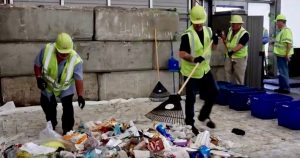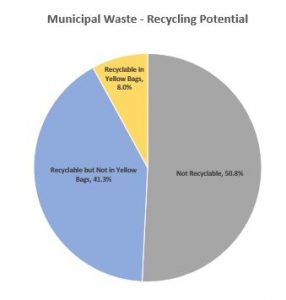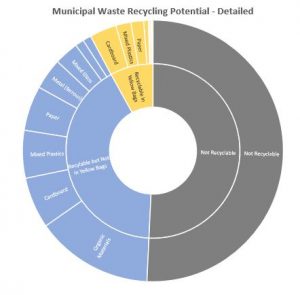
By Aaron Thelenwood, City of Holland
There is a lot of negative press lately regarding the current state of recycling, as wider geopolitical pressures have strained the overall recycling system, creating impacts felt at the local level.
As a result, more recyclable materials are finding their way into landfills rather than being sent abroad. Also, certain materials are being left out of the recycling equation entirely (previously foam products had been excluded, now glass, and some communities are also moving away from certain plastics). And, some communities across the U.S. and Michigan are suspending their recycling programs.
Compounding all of this is confusion related to the types of materials which are accepted curbside, a list which at times seems to change daily. Today, we’d like to walk you through a few key points to ease some concerns and frustrations, and to provide a clearer understanding of the current state of recycling.
1. What’s going on? China was a major disruptor, which cannot be overstated. The majority of the world’s materials were going to that one market, and China shutting its doors fundamentally changed the recycling ecosystem.
2. What happened? In a word: Contamination. For the better part of a decade, China had been voicing concerns over the poor quality of materials it was receiving due to contamination, leading to ecological issues the country had to struggle with.
3. What is contamination? Contamination is anything which doesn’t belong in the recycling stream – from greasy pizza boxes and half full mayo jars to plastic films, textiles, or carpeting.
Those changed policies in China have produced great challenges for the U.S., and for us in Holland, but also new opportunities. These silver linings include:
1. The Michigan Office of Environment, Great Lakes & Energy (formerly the DEQ) is investing more in recycling infrastructure now than it has over the last 30 years. It has established annual funding to the tune of $5.7 million for development of regional recycling markets, recycling infrastructure investment, and community education.
2. Even as recycling programs are more strained, public support for recycling continues to increase. Residents are demanding ongoing access, creating market demand for recycling services. Also, commercial recycling continues to steadily improve as companies become more conscious of the need to decrease their landfill material streams. Locally, we have great examples in Herman Miller, Haworth, and Steelcase who are effectively “zero waste” to landfills.
3. Although China created a substantial market disruption, it has also refocused everyone’s attention on recycling correctly and on system inefficiencies.
With that said, there will continue to be ups and downs, but by following a few key steps, we can all do our part to drive down contamination rates and increase the success of our recycling efforts locally.
(See sidebar on how and what to recycle.)
The City of Holland will continue to monitor the current state of the city’s material stream to identify opportunities for improvement. The city’s 2018 waste Characterization Audit data is available at: https://www.cityofholland.com/solidwasteandrecycling/waste-characterization-audit-2018


Further, the city’s Materials Management Taskforce is working to compare the city’s Yellow Bag recycling program to other standard recycling models. The goal of this taskforce’s work is to establish the City of Holland as a recycling leader both regionally and beyond.
![]() Want to know more about Recycling at Hope College? Click here.
Want to know more about Recycling at Hope College? Click here.
Aaron Thelenwood is solid waste and recycling education coordinator for Holland.
Much Material is Not Recycled
The city survey found large amounts of potentially recyclable materials are not being recycled. This is percentage being recycled of the total material in the waste stream.
Paper 60 percent
Cardboard 45 percent
Mixed Glass 40 percent
Metal (ferrous) 28 percent
Mixed plastics 26 percent
Metal (non-ferrous) 8 percent
SIDEBAR: Here’s How and What to Recycle Properly
The “how”
1. Clean, clean, clean! Make sure all containers are empty, clean, and dry! Empty means nothing inside; clean means no visual contaminants (but no need to run the dishwasher), and dry means dry.
2. Back to Basics. Only recycle what is specifically listed. In the past, recycling programs added more and more to the list of acceptable materials, which created confusion from one program to the next. It also led to the phenomenon known as “Aspirational Recycling” – the practice of trying to recycle something that seems recyclable, but is one of the major causes of contamination in recycling systems.
3. When in doubt throw it out. This may seem counterproductive and hard advice to swallow. But keep in mind that one wrong item in the recycling stream has a bigger detrimental impact than one recyclable material sent to the landfill. If you don’t know if something recyclable, err on the side of caution and toss it.
The “What”
1. Paper: Newsprint, office paper, junk mail, magazines.
2. Cardboard: Amazon boxes, the clean half of your pizza box, cereal boxes.
3. Plastic Containers (#1-7): “Containers” is key. No films, no “recyclable” plastic shipping envelopes (even if it has a number), no zip lock bags, and no plastic grocery bags. (Many of these items can be recycled through separate, specific third-party recyclers, but you might need to do some research.
4. Metal: ferrous (steel) and non-ferrous (aluminum).
5. (Maybe) Glass: The future of glass curbside is uncertain. Currently it is not accepted curbside and, over the past five-plus years, most recyclers were stockpiling the material, hoping the markets would return. So far, they have not, but innovative uses for glass are being explored – so hopefully more to come on that!
Remember: Don’t contaminate the stream. When in doubt, throw it out.
![]() This Week’s Sustainability Framework Theme
This Week’s Sustainability Framework Theme
Community Knowledge: The collective knowledge and energy of the community is an incredible resource that must be channeled to where it is needed.
![]() ABOUT THIS SERIES
ABOUT THIS SERIES
Living Sustainably is a collection of community voices sharing updates about local sustainability initiatives. It is presented by the Holland-Hope College Sustainability Institute, a joint project of Hope College, the City of Holland and Holland Board of Public Works. Go to www.hope.edu/sustainability-institute for more information.

